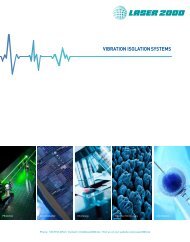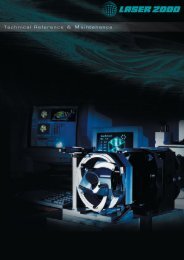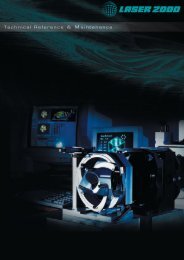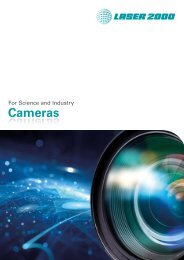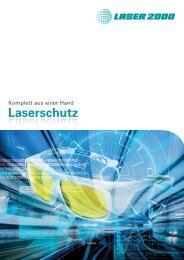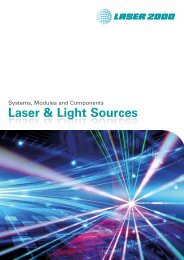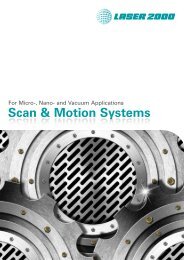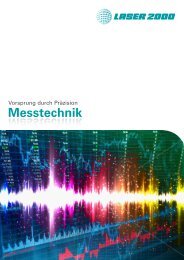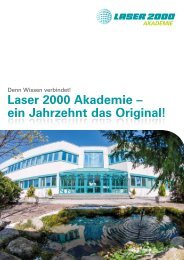Semrock Master Catalog 2018
Semrock Master Catalog 2018
Semrock Master Catalog 2018
Create successful ePaper yourself
Turn your PDF publications into a flip-book with our unique Google optimized e-Paper software.
Polarizers<br />
Mirrors NIR Filters<br />
Edge<br />
Filters<br />
Dichroic<br />
Beamsplitters<br />
Laser-line<br />
Filters<br />
Laser Diode<br />
Filters<br />
TECHNICAL NOTE<br />
Technical Note: Laser Damage Threshold<br />
Laser damage to optical filters is strongly dependent on many factors, and thus it is difficult to guarantee the performance of<br />
a filter in all possible circumstances. Nevertheless, it is useful to identify a Laser Damage Threshold (LDT) of pulse fluence or<br />
intensity below which no damage is likely to occur.<br />
P<br />
Ppeak<br />
Pulsed vs. continuous-wave lasers: Pulsed lasers emit light in a series of<br />
pulses of duration t at a repetition rate R with peak power P peak<br />
. Continuouswave<br />
(cw) lasers emit a steady beam of light with a constant power P. Pulsedlaser<br />
average power P avg<br />
1/R<br />
and cw laser constant power for most lasers typically<br />
P<br />
range from several milliWatts (mW) to Watts (W). The table at the end of this<br />
avg<br />
time<br />
Note summarizes the key parameters that are used to characterize the output<br />
of pulsed lasers.<br />
The table below summarizes the conditions under which laser damage is expected to occur for three main types of lasers.<br />
Units: P in Watts; R in Hz;<br />
diameter in cm; LDT LP<br />
in J/cm 2 .<br />
Note: l spec<br />
and t spec<br />
are the<br />
wavelength and pulse width,<br />
respectively, at which LDT LP<br />
is specified.<br />
* The cw and quasi-cw cases<br />
are rough estimates, and<br />
should not be taken as<br />
guaranteed specifications.<br />
Type of Laser Typical Pulse<br />
Properties<br />
Long-pulse τ ~ ns to µs<br />
R ~ 1 to 100 Hz<br />
cw<br />
Quasi-cw<br />
Continuous<br />
output<br />
τ ~ fs to ps<br />
R ~ 10 to 100 MHz<br />
When Laser Damage is Likely<br />
P avg<br />
λ<br />
R x (π/4) x diameter > 2 λ x Ʈ<br />
x<br />
Ʈ LDTLP<br />
spec spec<br />
P<br />
W λ<br />
(π/4) x diameter > ~10,000<br />
2 J<br />
x λ x LDTLP*<br />
spec<br />
P avg<br />
W λ<br />
(π/4) x diameter > ~10,000<br />
2 J<br />
x λ x LDTLP*<br />
spec<br />
Long-pulse lasers:<br />
Damage Threshold Long Pulse is generally specified in terms of pulse fluence for “long-pulse lasers.” Because the time<br />
between pulses is so large (milliseconds), the irradiated material is able to thermally relax—as a result damage is generally<br />
not heat-induced, but rather caused by nearly instantaneous dielectric breakdown. Usually damage results from surface or<br />
volume imperfections in the material and the associated irregular optical field properties near these sites. Most <strong>Semrock</strong><br />
filters have LDT LP<br />
values on the order of 1 J/cm 2 , and are thus considered “high-power laser quality” components. An<br />
important exception is a narrowband laser-line filter in which the internal field strength is strongly concentrated in a few<br />
layers of the thin-film coating, resulting in an LDT LP<br />
that is about an order of magnitude smaller.<br />
cw lasers: Damage from cw lasers tends to result from thermal (heating) effects. For this reason the LDT CW<br />
for cw lasers<br />
is more dependent on the material and geometric properties of the sample, and therefore, unlike for long-pulse lasers, it is<br />
more difficult to specify with a single quantity. For this reason <strong>Semrock</strong> does not test nor specify LDT CW<br />
for its filters. As a<br />
very rough rule of thumb, many all-glass components like dielectric thin-film mirrors and filters have a LDT CW<br />
(specified as<br />
intensity in kW/cm 2 ) that is at least 10 times the long-pulse laser LDT LP<br />
(specified as fluence in J/cm 2 ).<br />
Quasi-cw lasers: Quasi-cw lasers are pulsed lasers with pulse durations τ in the femtosecond (fs) to picosecond (ps) range,<br />
and with repetition rates R typically ranging from about 10 – 100 MHz for high-power lasers. These lasers are typically<br />
mode-locked, which means that R is determined by the round-trip time for light within the laser cavity. With such high<br />
repetition rates, the time between pulses is so short that thermal relaxation cannot occur. Thus quasi-cw lasers are often<br />
treated approximately like cw lasers with respect to LDT, using the average intensity in place of the cw intensity.<br />
Example: Frequency-doubled Nd:YAG laser at 532 nm. Suppose τ = 10 ns, R = 10 Hz, and Pavg = 1 W. Therefore D = 1 x<br />
10 –7 , E = 100 mJ, and Ppeak = 10 MW. For diameter = 100 μm, F = 1.3 kJ/cm 2 , so a part with LDT LP<br />
= 1 J/cm 2 will likely be<br />
damaged. However, for diameter = 5 mm, F = 0.5 J/cm 2 , so the part will likely not be damaged.<br />
Notch<br />
Filters<br />
Lamp Clean-up<br />
Filters<br />
Symbol Definition Units Key Relationships<br />
τ Pulse duration sec τ = D / R<br />
R Repetition rate Hz = sec -1 R = D / τ<br />
D Duty cycle dimensionless D = R x τ<br />
P Power Watts = Joules / sec P peak<br />
= E / τ; P avg<br />
= P peak<br />
x D; P avg<br />
= E x R<br />
E Energy per pulse Joules E = P peak<br />
x τ; E = P avg<br />
/ R<br />
A Area of laser spot cm 2 A = (π / 4) x diameter 2<br />
I Intensity Watts / cm 2 I = P /A; I peak<br />
= F / τ; I avg<br />
= I peak<br />
x D; I avg<br />
= F x R<br />
F Fluence per pulse Joules / cm 2 F = E / A; F = I peak<br />
x τ; F = I avg<br />
/ R<br />
More<br />
108<br />
Try out <strong>Semrock</strong>’s Laser Damage Threshold Calculator at www.semrock.com/ldt-calculator.aspx



